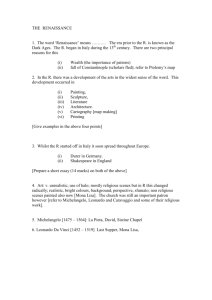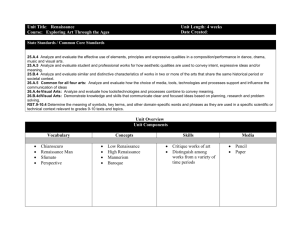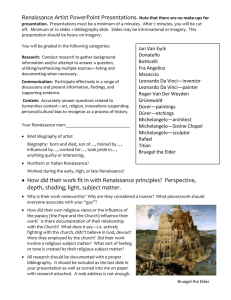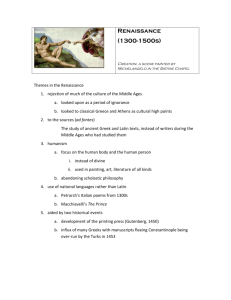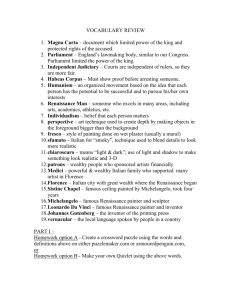The Hero as Artist2006
advertisement
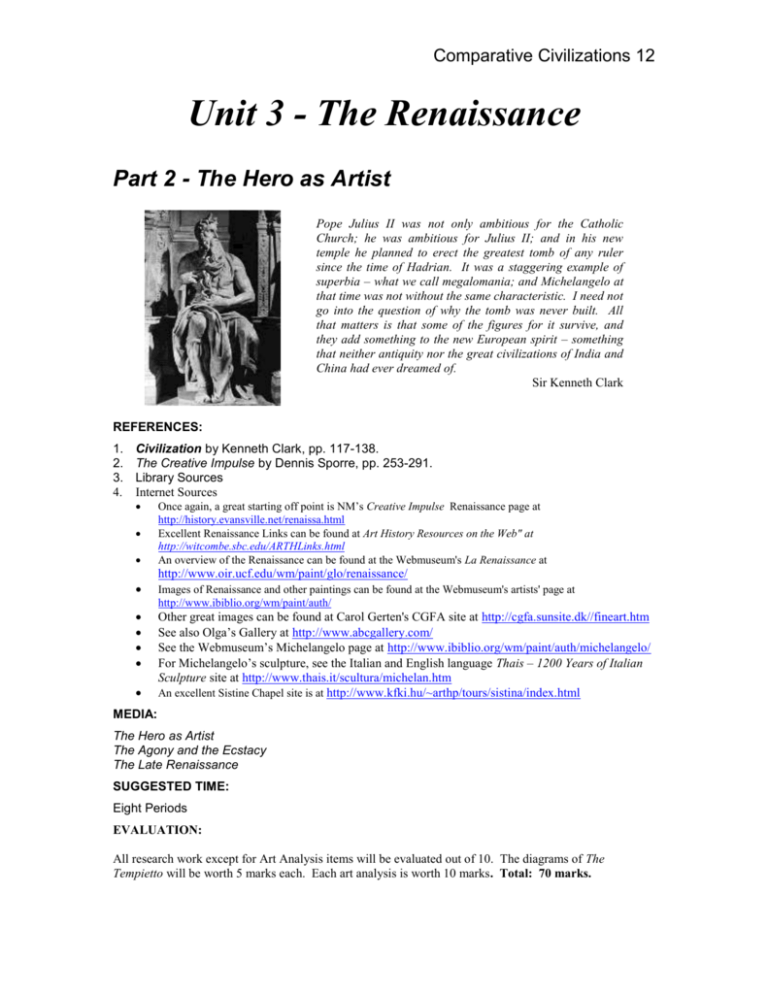
Comparative Civilizations 12 Unit 3 - The Renaissance Part 2 - The Hero as Artist Pope Julius II was not only ambitious for the Catholic Church; he was ambitious for Julius II; and in his new temple he planned to erect the greatest tomb of any ruler since the time of Hadrian. It was a staggering example of superbia – what we call megalomania; and Michelangelo at that time was not without the same characteristic. I need not go into the question of why the tomb was never built. All that matters is that some of the figures for it survive, and they add something to the new European spirit – something that neither antiquity nor the great civilizations of India and China had ever dreamed of. Sir Kenneth Clark REFERENCES: 1. 2. 3. 4. Civilization by Kenneth Clark, pp. 117-138. The Creative Impulse by Dennis Sporre, pp. 253-291. Library Sources Internet Sources Once again, a great starting off point is NM’s Creative Impulse Renaissance page at http://history.evansville.net/renaissa.html Excellent Renaissance Links can be found at Art History Resources on the Web" at http://witcombe.sbc.edu/ARTHLinks.html An overview of the Renaissance can be found at the Webmuseum's La Renaissance at http://www.oir.ucf.edu/wm/paint/glo/renaissance/ Images of Renaissance and other paintings can be found at the Webmuseum's artists' page at http://www.ibiblio.org/wm/paint/auth/ Other great images can be found at Carol Gerten's CGFA site at http://cgfa.sunsite.dk//fineart.htm See also Olga’s Gallery at http://www.abcgallery.com/ See the Webmuseum’s Michelangelo page at http://www.ibiblio.org/wm/paint/auth/michelangelo/ For Michelangelo’s sculpture, see the Italian and English language Thais – 1200 Years of Italian Sculpture site at http://www.thais.it/scultura/michelan.htm An excellent Sistine Chapel site is at http://www.kfki.hu/~arthp/tours/sistina/index.html MEDIA: The Hero as Artist The Agony and the Ecstacy The Late Renaissance SUGGESTED TIME: Eight Periods EVALUATION: All research work except for Art Analysis items will be evaluated out of 10. The diagrams of The Tempietto will be worth 5 marks each. Each art analysis is worth 10 marks. Total: 70 marks. Comparative Civilizations 12 Introduction: 1. In what city does the High Renaissance begin? To where does the focus then shift? Why is this so? (filmstrip and Clark) 2. Who was Michelangelo’s chief patron and what seems to be his goal? What were these two people like in terms of personality? (Agony & the Ecstacy) 3. Why is it that Leonardo da Vinci is sometimes regarded as the most brilliant mind of an incredible age? Explore the varied talents of this quintessential “Renaissance man.” (filmstrip, Clark, Sporre & Library sources) Painting: 1. According to legend, why was Michelangelo selected to paint the Sistine Chapel ceiling, despite his protests that he was a sculptor and not a painter? 2. Choose one scene from the Sistine Chapel Ceiling and complete an art analysis of it. 3. Select one of Leonardo’s paintings and complete an art analysis of it. 4. Complete an art analysis of the painting School of Athens. 5. What great artist became the most famous of Venice’s Renaissance artists? What is novel about his work? 6. Complete an art analysis of one of Titian’s paintings. Sculpture: 1. Complete an art analysis of Michelangelo’s David. 2. Compare Michelangelo’s David with Donatello’s and Verocchio’s earlier versions of the same subject. Architecture: 1. Sketch a floorplan and front or side elevation or section of Bramante’s small masterpiece, The Tempietto of St. Peter in Montorio, Rome. 2. What great building project did Pope Julius II appoint Bramante to direct? Why was he unable to complete it?
